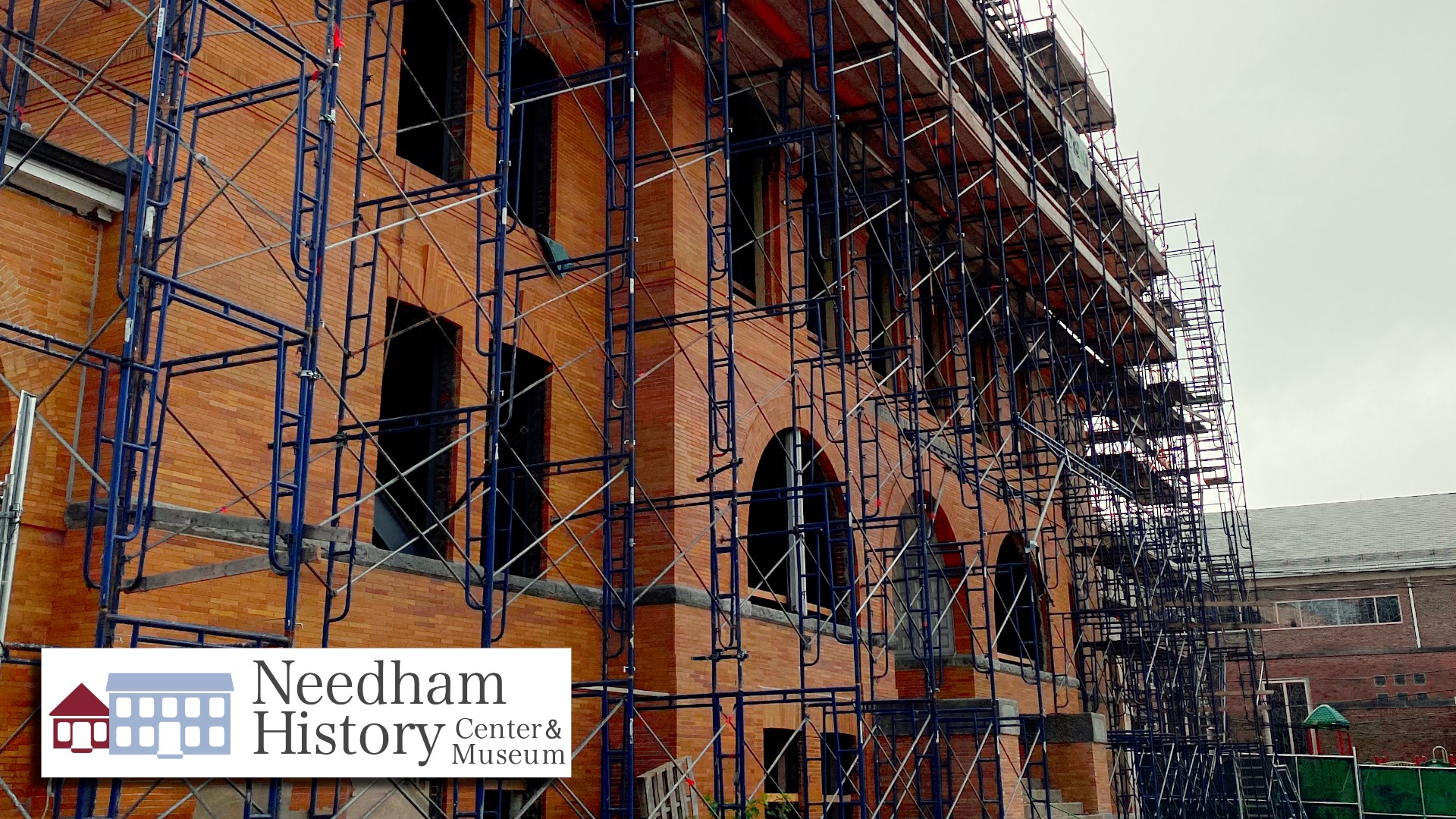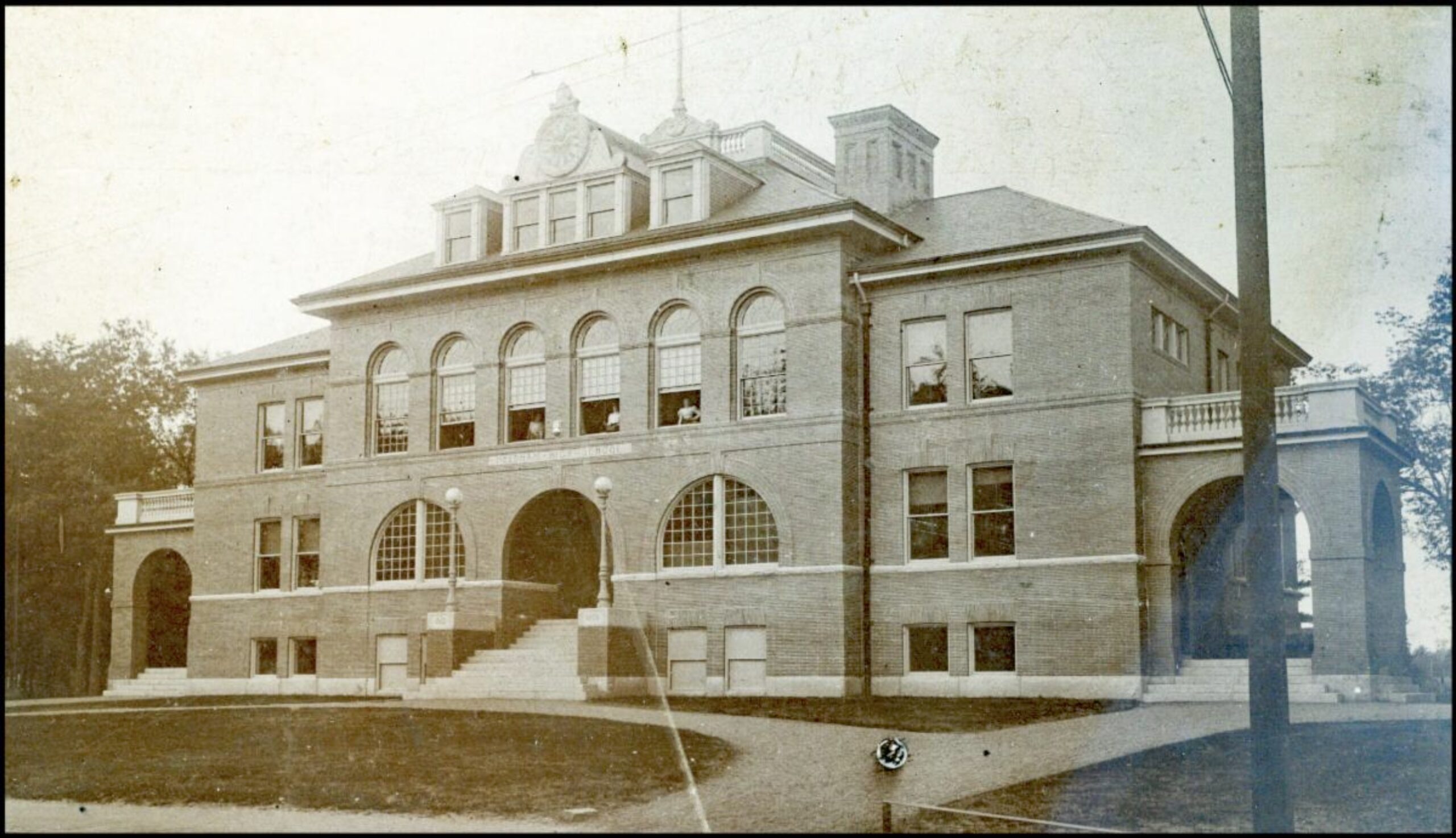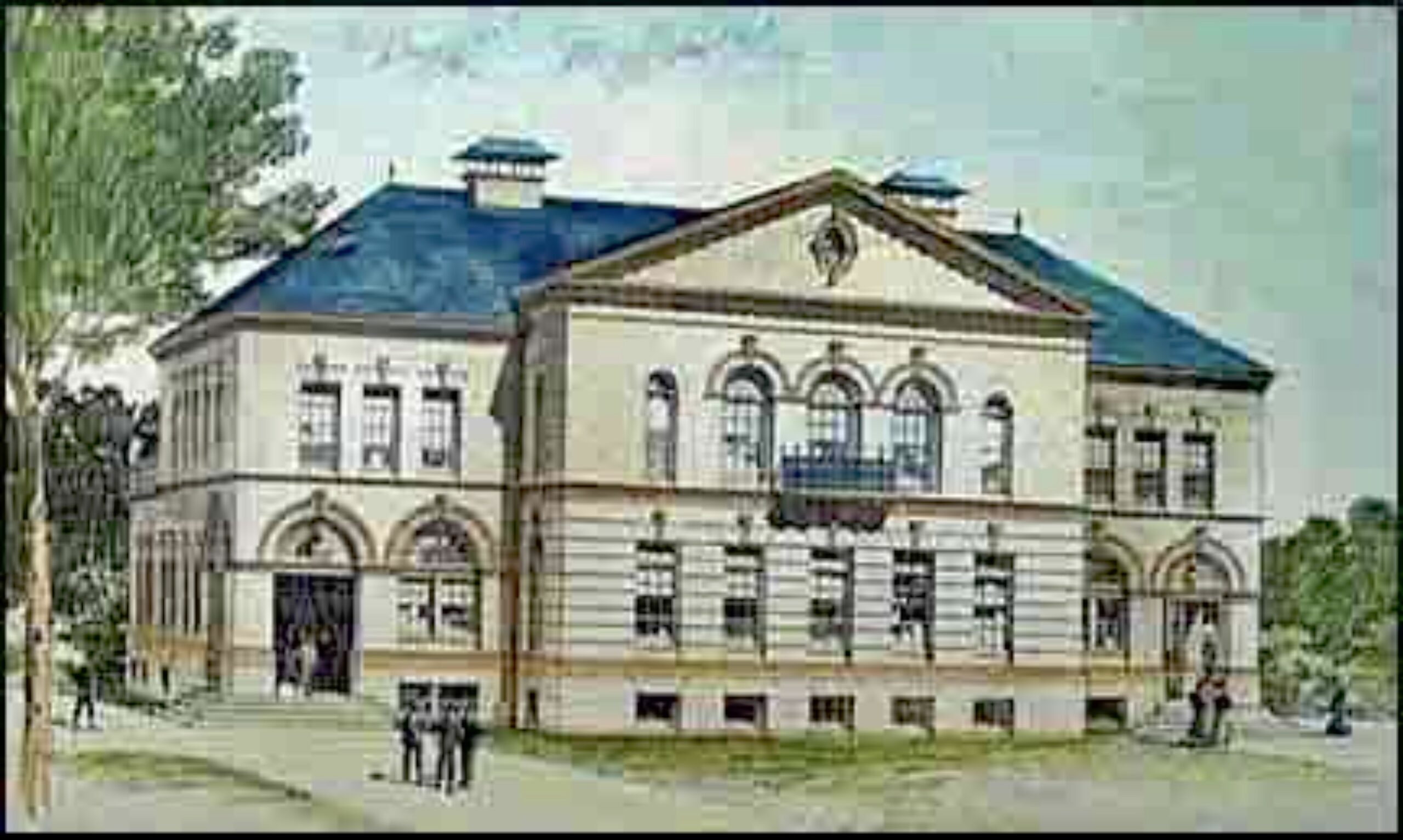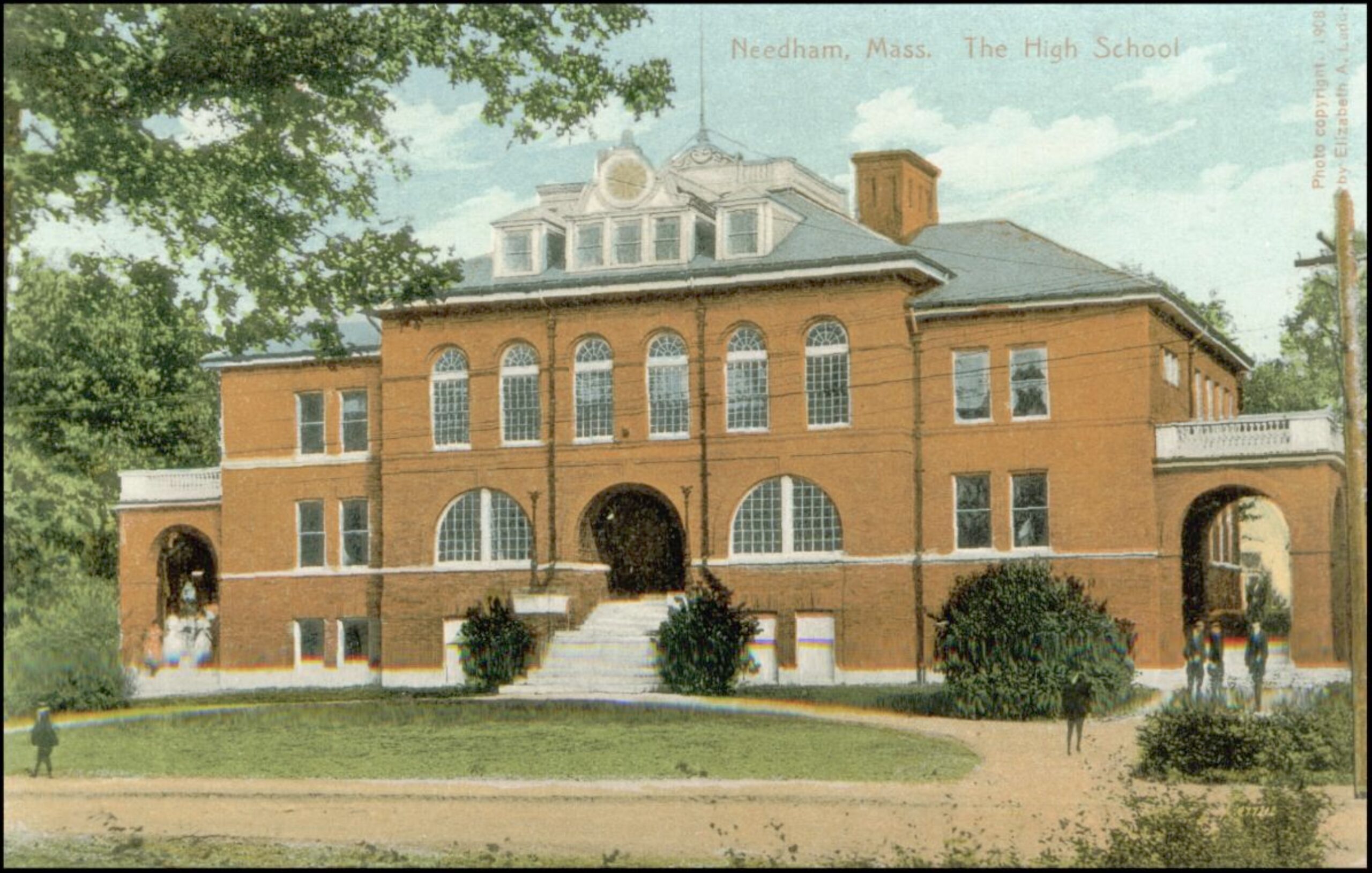
Needham History: An Italianate Palazzo in the Center of Needham
The very best Needham had to offer.

The Needham High School/Emery Grover Building, probably taken c. 1900, shortly after it was completed. The clock face above the entrance is now at the Needham History Center.
An Italian Palazzo in the Center of Needham
Almost every week, I drive by the construction at the Emery Grover site to check on the progress of the renovations and rejoice in the fact that this lovely building has been preserved for our town, and will soon be active and useful again. Yes, it was touch-and-go for a while. Whew~!
Hidden behind the scaffolding, and (to be honest) not all that noticeable before, are the dates 1865 and 1898 on the two pillars beside the entrance steps, and “Needham High School” above the arched main door. Although it has not filled that function for nearly 100 years, the Emery Grover was Needham’s first High School building. The dates commemorate the original establishment of Needham’s high school (1865) and the date that the building itself was completed (1898).
Discussions in Needham about the need to expand education by establishing a high school first began 1853, but it was not until 1864 that Town Meeting appointed a committee to look into the question. What the committee found was that state law already required each town to provide a high school, and that Needham was some years in default. Therefore, in March 1865 Town Meeting appropriated $2500 to establish two high schools, one in the eastern half of town and one in the western half (now Wellesley).
The new East High School opened in May 1865, in an upstairs room of the Kimball Primary School on the corner of Chestnut Street and School Street, sharing space with the fledgling Free Public Library; in the fall it moved to a rented room in Village Hall, above the General Store and Post Office on Great Plain Avenue. In 1868, a committee was chosen by Town Meeting to look into the question of dedicated buildings for the two high schools, but the effort rapidly dwindled.
Finally, in 1896, the question became urgent, as the number of students was much larger than the town’s makeshift arrangements could accommodate. Town Meeting appropriated $30,000 to purchase land and build a school. There was immediate disagreement in town over the school’s location. Residents of the Heights wanted the new high school to be in or at least near the Heights, while residents of the Center wanted it in the Great Plain. The town proposed either replacing and enlarging the Kimball School on School Street to better accommodate both the grammar school and the high school, or adding a separate high school building to the site alongside the Kimball School. Neither faction liked this plan, since the Kimball was already deteriorating and possibly unsafe, and the growing high school classes needed more space.
Despite the disagreement over location, Town Meeting’s high school planning committee moved forward, contracting with architect Charles Bingham for a design of the building. Bingham was an important Boston-area architect, known for numerous private and public buildings, including townhouses on Beacon Hill and the Back Bay, railway stations, churches, and commercial blocks – most notably the State House Annex, the old YMCA Building on Boylston Street, the original Museum of Fine Arts in Copley Square, residential and commercial properties for the Hunnewell family, and several homes for John and Isabella Stewart Gardner.
Bingham’s design was unique for Needham. The town was just making a (slow) transition away from Colonial architectural styles. The new high school was designed to look like an Italianate palazzo, with arched windows, decorative ironwork, and busts of philosophers over the arched doorways.

The rendering of the accepted design for the Needham High School, made by Charles Bingham in 1896. Comparison of this image with the finished building shows how closely Whitman and Hood adhered to (even borrowed from) Bingham’s design. The Bingham design had numerous decorative embellishments that were not included in the final Whitman and Hood building, significantly lowering the cost of construction.
However, the ongoing disagreement over the location of the school held the project up. Then in 1897, local businessman John Moseley offered to resolve the location issue by giving the town a plot of land that he owned on Highland Avenue, between May Street and Oakland Avenue next to St. Joseph’s Church. The town accepted the offer, and a new committee was formed to carry the project forward.
This new committee hired another architectural firm, Richard Percival Hood and Edward Payson Whitman, a brief partnership known mainly for Gothic-style school buildings in the Boston area. This led to a breach-of-contract suit by Bingham for $1000, who had not yet been paid for his work and design; the town finally settled with Bingham for about $600. Bingham had a legitimate beef – Whitman and Hood essentially commandeered Brigham’s design. Although they claimed it as their own, a comparison of the Bingham design with the finished building shows that they are essentially the same, with some simplification of the façade by reducing the decorative elements (and, presumably, the cost). When finished, the building was praised as “unexcelled by any other high school building erected in Massachusetts for an equal amount of money.”
The new high school opened in 1898. It served three grades of about 15 students each, with five classrooms, an auditorium, a laboratory, and a darkroom. However, it rapidly became too small as the student population grew. By 1924, a companion building was built next to it (the former Highland Avenue School), and by 1930, and new building was built on a new site – the current Needham High School.
The old building was renamed the Emery Grover Building in 1935, in honor of a man who was a prominent MA judge, Town Moderator for 20 years, and a member of the School Committee for 20 years. It served as overflow space for the Highland Avenue School and the High School. In the 1970s, it became the offices of the School Department, as it remains today.
The Emery Grover Building is Needham’s oldest public building and an iconic structure at the gateway to the downtown. It is listed in the Needham Historic Inventory, and the MA Register of Historic Places. It was accepted to the National Register of Historic Places in August 1987 on the basis of its characteristic architecture and the integrity of its original design. (It is noted, by the way, that the National Register document credits both Charles Bingham and Whitman and Hood as the architects).
Time has not been kind to the Emery Grover Building. Structural damage in the 1930s led to the closure of the top floor for public use. The space inside has been partitioned beyond recognition to accommodate the staff needs of a modern school system. And subsequent aging, deferred maintenance, and ill-advised replacements diminished both the appearance and safety of this once-beautiful structure.
After much debate, the town decided in 2021 that renovation, and not replacement, was in fact the best option for the EGB. Despite the challenges, the Emery Grover is still usable and useful. Its location is ideal – in the center of town and near the other town offices – facilitating access for the public and the necessary communication between town officials. Its location, just steps from both the bus and the commuter rail, is also important for families who might need to reach the building by public transportation. Renovation was also the most cost-effective solution – especially since historic renovations are eligible to apply for Community Preservation funding.
The Emery Grover Building has been the gateway to Needham Center for 125 years. It represents the progress and aspirations of our town as it entered the new millennium. Whatever the disagreements that attended its conception, the town was united in its belief and desire that the building should represent the best Needham had to offer – to its students, and to its residents. We were proud that it was “unexcelled.” This precious and beautiful building is now being restored, its site landscaped, and its appearance once again something for us to be proud of – a unique historic landmark – an Italianate palazzo in the center of Needham.
Color-lithograph postcard of the Needham High School / Emery Grover Building, photographed by Elizabeth Ladd in 1908.

 |
Gloria Polizzotti Greis is the Executive Director of the Needham History Center & Museum. For more information, please see their website at www.needhamhistory.org. |

